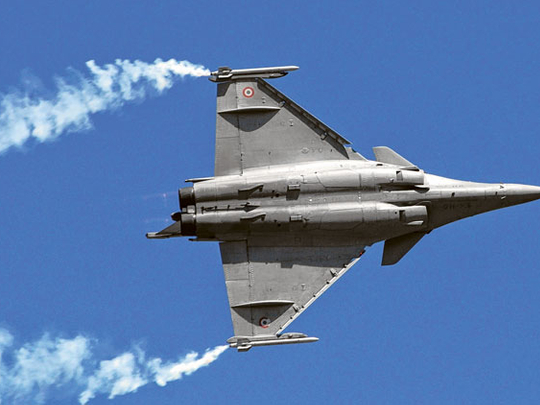
Dubai: To the surprise of some, India has brushed aside tenders from US and Russian manufacturers to award the $12 billion (Dh44.04 billion) deal to supply 126 multi-role fighter aircraft to European firms.
In the tough bidding process for a contract that is being seen as one of the decade's biggest, New Delhi has short-listed the Rafale, made by France's Dassault Aviation, and the Eurofighter Typhoon, built by European Aeronautic Defence and Space, a consortium of Spain, Germany, Britain's BAE Systems and Italy's Finmeccanica.
Incidentally, the Rafale and the Eurofighter are seeing action over the skies of Libya as part of Nato's military campaign.
Speaking to Gulf News, Laxman Behera, Research Fellow at the Institute for Defence Studies and Analyses, a New Delhi-based think-tank, said India's move was a "big blow" to the US. "When there is international bidding, involving multiple foreign companies, the stakes are very high. It is very competitive. The final decision is a big blow to the prestige of the US companies."
Surprising
According to Behera, the Indian Air Force had listed more than 600 parameters to evaluate the aircraft. But he said he found it difficult to believe a highly advanced fighter jet like Boeing's F/A-18 Super Hornet could not pass the test. "It took a long time, as the aircraft had to be tested in different climatic conditions. But it is a bit difficult to digest that Boeing was excluded. It is surprising."
American ambassador to India Timothy Roemer, who announced on Thursday that he was resigning for "personal reasons", said the US government was "deeply disappointed" by the decision.
But asked about the implications of the deal on New Delhi's growing strategic and economic relationship with Washington, Behera said he did not believe there would be a negative impact in the long term. "It was a big contract. And the US administration was trying hard to persuade the Indian government. There will be some short-term bitterness. But in the long-term, I don't think it will have much impact. In the past four to five years, US companies have been awarded many big defence contracts. In any case, no company has the liberty to ignore the Indian market."
Spending spree
Indeed, India has been on a spending spree, lately. The country's defence budget for the fiscal year which ended in March rose by more than 11 per cent, to $36.28 billion.
Defence experts believe India will spend between $50-80 billion on armaments in the next five years. The army is looking for artillery while the air force will be shopping mainly for attack helicopters. And a significant portion of that is likely to go to US weapons manufacturers.
India's traditional arms supplier, Russia, also lost out on the deal, when its MiG-35 was rejected. "The MiG-35 didn't stand a chance. It was least likely to be selected. It was not up to the task," said Behera.
Reputation problem
The MiGs also have a reputation problem in India, with the MiG-21s being branded "flying coffins" as a result of the deaths of numerous Indian Air Force pilots in crashes.
Sweden's Saab Gripen and Lockheed's F-16 Super Viper were also in contention.












